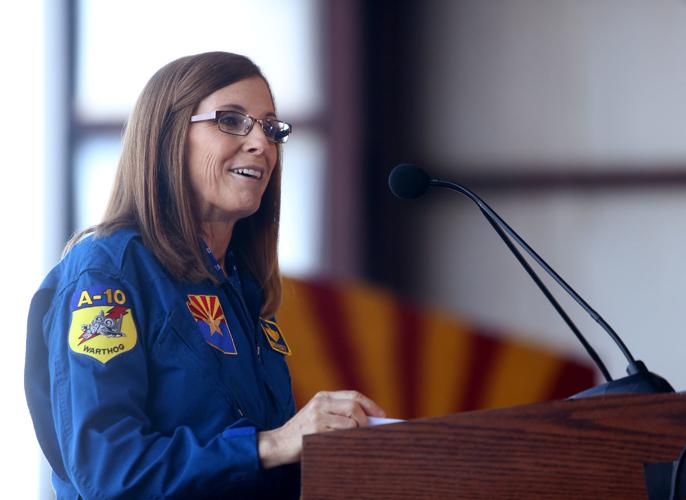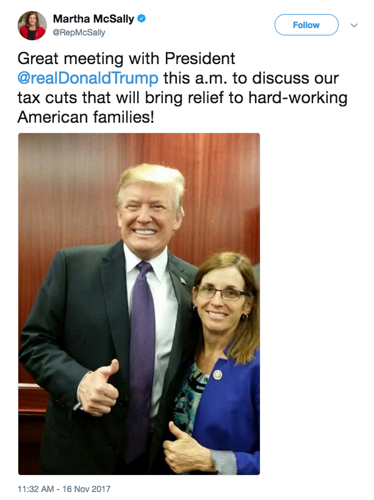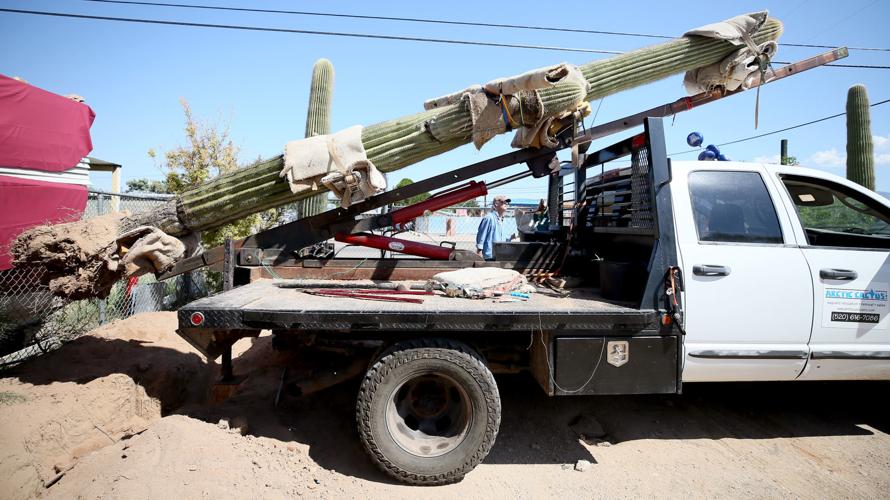Since the start of her campaign for U.S. Senate last year, Rep. Martha McSally’s need to remake herself into a Trump Republican has been the clearest obstacle to her winning the GOP nomination.
After being noticeably cool to Trump throughout his successful run for the presidency, suddenly last fall she began appearing in pictures and events with the president and applauding his policies. Not coincidentally, that was the beginning of her consideration of a Senate campaign.
But the contortions she’s putting herself through have never been as clear as they’ve become over the issue of so-called “dreamers” — those who qualified for the Deferred Action for Childhood Arrivals program. Her top Republican opponent is trying to make her pay for this flip-flop.
Last year, McSally signed on as co-sponsor of a bill, the Recognizing America’s Children Act, that would have allowed qualifying children of parents in the country illegally to apply for five-year conditional status. After that, they could apply for a second five-year period during which they could potentially become permanent legal residents.
In a press release last September, McSally noted that those who have signed up for DACA voluntarily gave the government their personal and biometric data. She emphasized a line from a letter signed by her and nine other Congress members: “It would be wrong to go back on our word and subject these individuals to deportation.”
Then, last week, she asked for and received unanimous consent from the House to remove her sponsorship of that bill.
Instead, she is supporting a bill she co-authored in January, the Securing America’s Future Act, which would treat DACA recipients more strictly. They would have to reapply every three years for legal status and have no special path to permanent residence.
More broadly, the bill ends family-based green cards for immigration (what opponents call “chain migration”) and reduces overall immigration by 25 percent, among other strict terms.
In Tucson this week, her opponent, former state senator Kelli Ward, criticized McSally for backing out of her earlier commitment on DACA.
“I don’t take my name off of bills when they become politically unpopular,” Ward said.
Now, it is fair to point out that McSally was a co-author of the second, stricter bill, so naturally she would want it to be clear that’s the one she supports. But it also seems no coincidence that removing her support from the first bill protects her right flank — that’s her most vulnerable side as she tries to win the nomination.
Martin targets fellow Dems
An interesting race for the state House has been shaping up among Democrats in Legislative District 9. The district has two Democratic incumbents, Reps. Randy Friese and Pamela Powers Hannley, but a new candidate has jumped in to challenge them.
More specifically, he seems to be challenging Powers Hannley.
His name is J.P. Martin, and he’s offering himself as a business-friendly millennial. This week he spoke to the Democrats of Greater Tucson, and his explanation of his candidacy could have been clearer. After talking about the changing economy, he said:
“Why am I running? Because I think that we need to take advantage of these opportunities, to learn about growth, to accept automation and to intertwine it with civic engagement so that we can tackle other key issues that will be root causes to what the future will look like.”
Hmmm. He went on:
“What do I think I can I do at the Arizona Legislature? Legislators are known to connect resources to their community, to connect to new markets, to give people a reason to find more opportunity in our city, to grow across our borders and to reduce the risk of living in Tucson if you’re young and not retired.”
Me, I still don’t really get it. But Powers Hannley was a strong critic of the extension of the Rio Nuevo district, and Martin supported it. So there’s that.
But, as she told me Thursday, “He’s trying to paint me as too far left, but he’s pretty far right of the House Democratic caucus the way it is right now.”
Did the cactus bring Amazon after all?
Many people had the same question I did after Amazon announced this week it will build a huge new warehouse on Tucson’s southeast side, for fulfilling orders made in this region.
Did the saguaro do it?
You may recall that back in September, when Amazon announced it is seeking to build a massive new headquarters, Tucson-area officials planned to send the company a saguaro as part of its bid for the project. In the end, Amazon asked that it be kept in Tucson, and officials promised to plant it at the Arizona-Sonora Desert Museum.
The gimmick did get noticed around the country and was even featured in the New York Times, but I panned it, as many other locals did. So, did it work after all by bringing us this new facility? Sadly, no, company spokeswoman Lauren Lynch told me.
“The saguaro didn’t have anything to do with the location of the fulfillment center,” she said.







